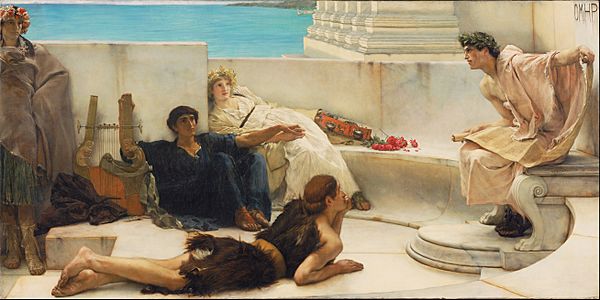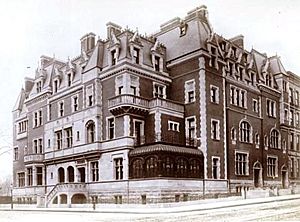A Reading from Homer facts for kids
A Reading from Homer is a famous painting created in 1885 by the English artist Lawrence Alma-Tadema. It shows an imagined festival scene from ancient Greece. Young people are reading poetry to a small group of listeners. They are on a beautiful marble balcony looking out at the sea. This painting has been at the Philadelphia Museum of Art since 1924.
Contents
How the Painting Was Made
This painting was ordered in 1882 by an American banker named Henry Gurdon Marquand. He liked Alma-Tadema's work and wanted a larger painting.
At first, the artist planned to paint Plato, a famous Greek thinker, teaching his students. They would be in a marble courtyard by the sea. Alma-Tadema worked on this idea for a long time. But he wasn't happy with it.
So, in 1885, he started fresh. He painted a similar scene, but this time it became A Reading from Homer. The artist even changed some parts as he painted. For example, he changed the arm of the person speaking.
What the Painting Shows
A Reading from Homer shows a scene on a marble balcony in ancient Greece. You can see the sea in the background.
On the right side of the painting, there are Greek letters on a wall that spell "HOMER". Below this, a young man is sitting. He wears a laurel wreath on his head, like a crown. He seems to be reading from a scroll, but he has looked up to his audience. It's not clear if he is meant to be Homer himself, or just someone reading Homer's poetry.
Four people are listening to him. They are standing, sitting, or lying on a marble bench and the floor. They are dressed for a festival. One man is standing. Another man is lying down, wearing goat skins, perhaps a shepherd. A couple is relaxing, holding hands. They have musical instruments: the man has a cithara (a type of harp) and the woman has a tambourine.
The scene looks like a festival. The woman and the standing man have garlands of flowers on their heads. There is also a pile of roses on the bench. The painting is large, measuring about 91.8 by 183.5 centimeters (36 by 72 inches). It brings ancient Greece to life, even though it's not meant to be perfectly accurate historically.
Where the Painting Has Been
Before the painting was even finished, Alma-Tadema was asked to design the furniture for Marquand's music room in his New York City home. The artist got ideas from ancient Greece and the Roman city of Pompeii.
A Reading from Homer was placed on a wall in this special music room. Another painting by Alma-Tadema, Amo Te, Ama Me, was also there. The room also had a beautifully decorated piano and ceiling paintings.
Later, Marquand sold many of his artworks. In 1903, A Reading from Homer was sold for a high price to an art collector named George W. Elkins. Elkins later gave the painting to the Philadelphia Museum of Art. It has been there since 1924 for everyone to enjoy.
Images for kids
See Also






